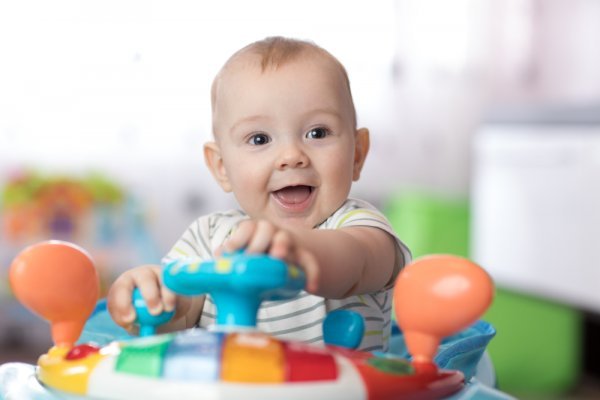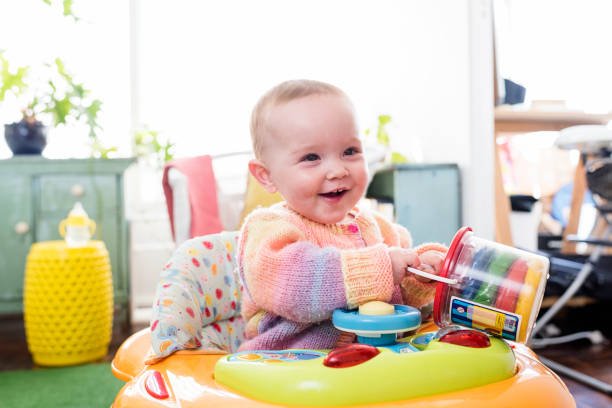When my middle son was about 8 months old he started standing up while balancing on the couch and other furniture. He showed a lot of interest in trying to walk but lacked the balance required. We took a drive to the local Goodwill and looked around the kid’s section. We found a lightly used walker and decided it would be a good idea to let my son start using it.
We took it home, gave it a good cleaning and introduced him to using the walker. The first time he approached it he pulled himself up and had a big smile on his face. He instantly fell in love with it and we all smiled as we watched him traverse the living room. He went on to use it for several months, even after he had learned to walk quite well.
We were sure to never leave my son in the walker for more than 20 to 25 minutes at a time. Not all walkers are going to be comfortable and your baby can’t tell you that something is not feeling right. Pay close attention to crying or other sounds of discomfort or general unhappiness. They may need to take a break and crawl around a bit on the floor.
Baby walkers can be a very controversial topic these days. There are people that feel strongly on each side of the argument. It can be hard to know what to do as a new parent. We’ll discuss what the professionals say and the best thing you can do is to use that information to decide what’s best for your child.
View in gallery
What is the Right Age for a Baby Walker?
The right time to introduce a baby walker depends on your child’s size, strength, and development. It’s recommended that your baby should be able to hold his head up and have his feet able to touch the floor while using the walker. Most walkers are designed for use by infants age 4 to 16 months. It is not recommended for children that are already able to walk.
Are Walkers Bad for Babies?
There are different opinions on this topic, but the American Academy of Pediatrics (AAP) advocates the banning of all baby walkers. They have cited numerous injuries and negative effects on infant development. They say that using a walker can delay physical milestones related to crawling and walking. Many professionals suggest that limiting the use of walkers is very important and while they may be convenient, they should not be overused. The American Medical Association even called walkers a “lethal form of transportation”. As a parent, this is at the least, concerning.
Parents have used walkers over the past decade to keep their babies busy and out of harm’s way while they do housework or have their attention split on other things. It can be quite the godsend when you need to get things done while your baby or infant is awake. Many professionals have voiced their opinions about walkers. Here are a few quotes from physical therapists and doctors.
I don’t think the advantages of walkers and saucers override the disadvantages.
Debi Kardon, PT, Coorhees, NJ
There is concern that the overuse of a walker or saucer can stunt development and cause infants to start walking much later than normal. It can also be bad for their hips and joints.
We’ve seen children who are over 18 months old who aren’t walking. Usually children walk when they are between 11 and 15 months. The only known condition these babies have in common is spending an inordinate amount of time in a walker or saucer.
Mary Weck, PT, Children’s Memorial Hospital Chicago
Many professionals note that using a walker can cause issues into adulthood, related to back pain and posture.
They arch their back in an unusual way. That posture can cause back pain in adults, and there may be potential for long-term disability.
Mary Weck, PT, Children’s Memorial Hospital Chicago
Are Baby Walkers Safe?
If you’re looking at this study in the journal Pediatrics, then the answer is an overwhelming no. This study looked at children less then 15 months old, from 1990 to 2014 that were treated in US emergency rooms for injuries related to walkers. There were more than 230,000 cases! This is an alarming amount of children being hurt using walkers. Most of these cases happened from walkers falling downstairs. Infants would injure their neck or head, sometimes very seriously.
Even the remote possibility of this happening to my son would have made me get rid of his walker immediately. Luckily we never had any issues, but it could have easily happened. Infants can go much faster in a walker then if they were crawling. They can go upwards of 3 feet a second, which means they can get to those stairs, or near the pool, or a hot stove, faster then you can react. If your attention is distracted for even a moment, that unthinkable thing could happen.
Beyond the serious injuries, children have been known to pinch fingers, pull things down on themselves that they wouldn’t normally be able to reach, grab sharp or dangerous objects, or even fall out of the walker. There are just too many ways for injuries to happen with a walker or saucer. There are so many disadvantages, I just can’t recommend that anyone use one.
Some parents think that using a walker will help their baby learn to walk faster. This just simply isn’t the case. Walkers can delay independent walking because babies are not strengthening the muscles they need to walk and are not practicing balance. Babies love to stand upright, so it’s tempting to give them access to a walker, but in the long run, it’s just not worth it.
View in gallery
What Can I Use Instead of a Walker?
There are several good alternatives to using a baby walker. Most anything that is stationary and keeps your child entertained is going to be a winner. I’ll list my top choices below so you can take a look.
#1. Baby Jumpers
Baby jumpers may seem really similar to baby walkers, but the main difference is that they are stationary. This reduces the chance of an accident. I checked out the most popular doorway jumpers and found that the Graco Doorway Bumper Jumper was the best choice. It’s inexpensive, highly rated and has toys attached to keep your infant busy.
#2. Activity Centers
These can come in many different forms but typically they are a combination between a baby walker and a stationary jumper. Usually, there are lots of different toys surrounding the toddler so they will keep busy for long periods of time. The advantage here again is that they can’t go anywhere. I reviewed the top activity centers and decided the Fisher-Price 2 in 1 sit to stand activity center was the best value. With multiple height adjustments and a 360-degree spin, it is very versatile.
#3. Sit to Stand Learning Centers
This is a great option because it can work with multiple age ranges. If you don’t want to wait until your baby is at walking age, there is still plenty that your baby can do at the sitting and crawling age. These still have wheels and can be pushed, so you’ll want to keep a close eye on them and make sure they can’t get near any stairs. I looked at all the best options on Amazon and decided that the VTech Sit-to-Stand Learning Walking was the best product.
Final Thoughts
At the end of the day, we’re all parents and we all love our kids. We want them to be happy, healthy and safe. Parents that let kids use baby walkers are not purposefully trying to put their children in harm’s way, oftentimes they are just not aware of the risks. If you ultimately decide to let your baby or infant use a baby walker, make sure they are in a safe area, where they cannot fall down any stairs or fall into a pool. Keep a super close eye on them and stay in close proximity in case they need you.
There is plenty of research that shows baby walkers to be dangerous, but at the same time, babies and infants love them, they can be a fun toy and give parents a break. If you decide to use them, be smart, be attentive and make sure your kids stay safe. Good luck everyone and be careful out there!









